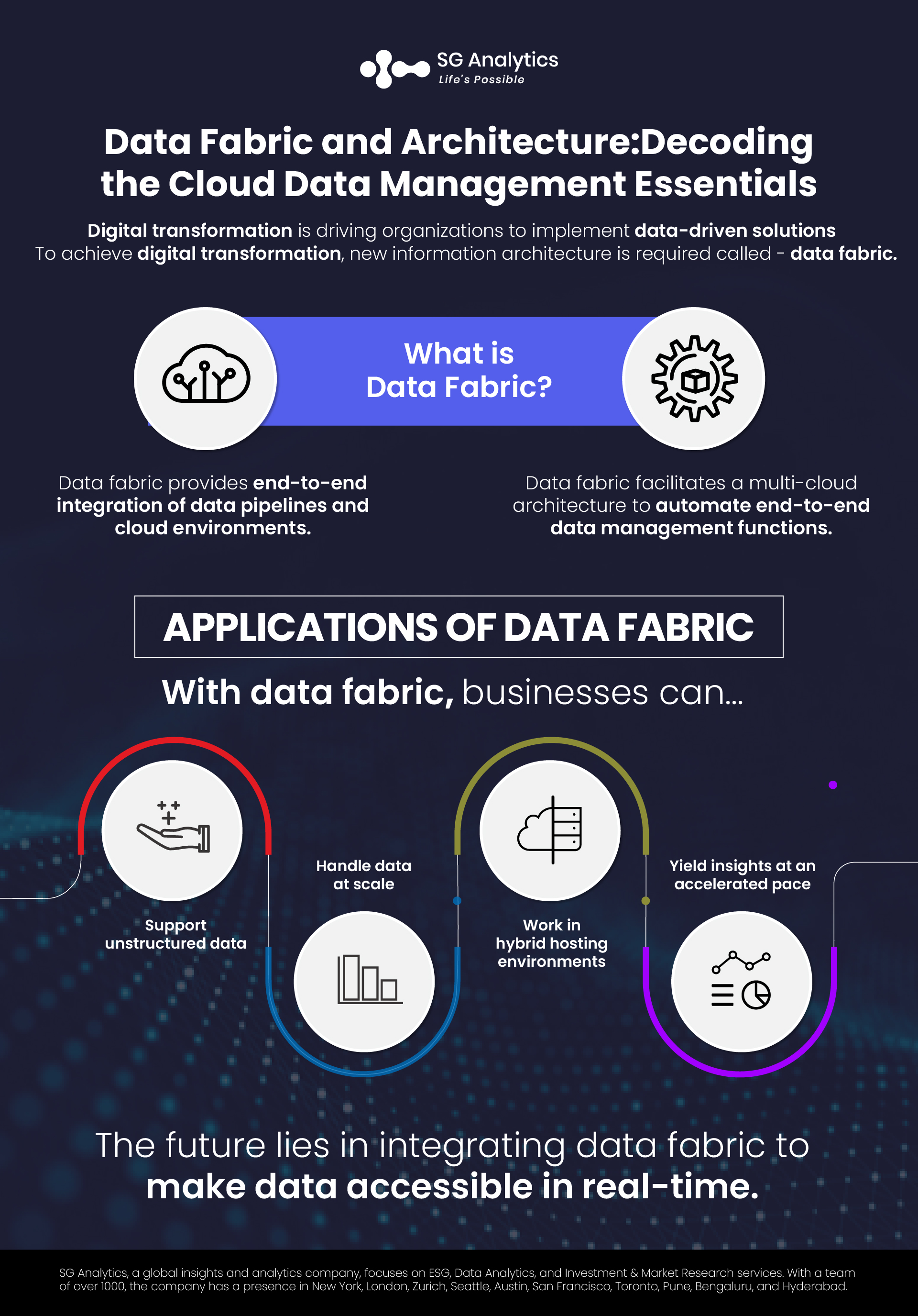Digital transformation is driving organizations to implement data-driven solutions to transform business outcomes like advanced analytics, artificial intelligence, and machine learning.
With enterprise data needs evolving, businesses are grappling to come to terms with the complex and heterogeneous nature of the data, along with the fact that it resides in multiple applications and environments scattered across the business landscape.
As per Statista reports, the global data generation and consumption volumes are set to cross 149 zettabytes by 2024, and unstructured data will comprise around 80%.
But achieving digital transformation is not an easy task for many organizations. It mandates a new information architecture called the data fabric. Businesses are now perceiving data fabric as a potential answer to this problem.
The data fabric is based on open standards, and its design scales horizontally across virtualized commodity infrastructure components. The data fabric facilitates a multi-cloud information architecture to automate end-to-end data management functions. However, new infrastructure frameworks are required to support the data fabric.

Data fabric improves upon the traditional concepts of data warehouse and data lake to introduce an architecture that facilitates uniform data utilization across the enterprise. Gartner identified data fabric to be one of the top 10 most influential data and analytics technologies in 2019 and stated that by 2022, organizations would be compelled to redesign their infrastructure to support bespoke data fabric designs.
Read more: A Brave New World – Fascinating Real-Life Applications of Data Analytics
What is a Data Fabric?
Data fabric is an architecture that provides end-to-end integration of data pipelines and cloud environments through the application of intelligent and automated systems. Developments within the hybrid cloud, artificial intelligence, the internet of things (IoT), and edge computing in the last decade have led to the exponential growth of big data, thereby creating a more complex environment for enterprises to manage. This has led to the unification and governance of data environments becoming a priority. This stimulated growth has created significant challenges like data silos, security risks, and general bottlenecks to decision-making.
Data management teams are now working to address these challenges head-on by implementing data fabric solutions. They are leveraging data fabric to unify disparate data systems, embed governance, as well as to strengthen security and privacy measures. This is allowing businesses to provide more data accessibility to their workers. These data integration efforts through data fabrics are assisting in a more holistic, data-centric decision-making.
.jpg)
Historically, an enterprise has had diverse data platforms aligned to specific lines of business operations. With a data fabric, decision-makers can view this data in a more cohesive manner to understand the customer lifecycle and build connections between data that did not exist before. By sealing these gaps in understanding of customers, products, and processes, data fabrics are assisting in accelerating digital transformation and automation initiatives across different business domains.
Applications of Data Fabric
Let's understand the key functionalities and enterprise applications of the data fabric.
-
Data fabrics support unstructured data.
-
Data fabrics handle data at scale.
-
Data fabrics are consistent with hybrid hosting environments.
-
Data fabrics yield insights at an accelerated pace.
-
Data fabrics demand less IT intervention.
-
Both technical and non-technical users can employ data fabrics.
Read more: What Is Data Democratization? How is it Accelerating Digital Businesses?

Decoding the Cloud Data Management Framework
Large-scale data consumption is driving up data storage requirements. To facilitate acceptable performance for most data-driven workloads, this emerging design concept - data fabric - offers a robust solution to ever-present data management challenges.
The cloud data management framework delivers three essential services to the data fabric.
-
Link: Data-driven enterprises depend on data pipelines to feed the downstream applications, whereas the cloud data management framework is responsible for collecting and transferring data from one source to another. One of the core competencies that data fabric facilitates for the data-driven enterprise is that it offers them the ability to connect to any data source. They can not only move large volumes of data but also transform and organize the data for use.
-
Record & organize: One benefit of a centralized data repository is it offers an enhanced, improved ability to explore the data. With data catalogs, businesses can understand the assembled data with indexes, descriptions, metadata, and business glossaries and create improved context. However, once the data is cataloged, proper data governance is equally essential to ensure data security, compliance, and privacy.
-
Discover: In order to analyze the entire data landscape, the data must be accessible not only through API but also through text searches and ad hoc queries. Role-based access controls offer the least privilege necessary to provide universal access to the data without compromising data privacy and compliance.

Cloud data management operates either as a private cloud solution managed by in-house resources or a SaaS subscription. An essential application framework, cloud data management offers the tools and use cases required to collect, store and prepare data pipelines. Once data is assembled and ingested into a common data platform, cloud data management applications help in pipelining, enriching, transforming, and preparing the data for later use. It helps in gaining increased control as common data platforms enable security, data governance, and access control that can be monitored from a single point.
Read more: It's Time to Put Marketing at the Data Table. Why?
Top Cloud Data Management Applications for Data Fabric
-
Data lakes
Data lakes are storehouses of current data accumulated to feed data-driven applications. Advanced analytics, machine learning (ML), and artificial intelligence (AI) applications require some data transformation, data cleansing, or data enrichment in preparation for processing. Data lakes act like the building blocks of data pipelines and provide a data preparation platform to make data structured and fit for use by data-driven applications.
-
Archives
Archives act as centralized repositories of 'historical' data that assist in improving data governance and compliance through the principle of data minimization. This simply states that data can be retained only for as long as minimally necessary and only to fulfill a defined purpose. By archiving historical data from production databases, file servers, and email servers, organizations can improve the performance of their production applications as well as optimize their data framework and reduce the high cost of production infrastructure.
Archives also facilitate application retirement and decommissioning of legacy systems that are no longer required. Businesses can achieve significant cost savings and improved data compliance by rationalizing application portfolios and retiring their outdated applications with compliance policies.

-
Consumer data privacy
Consumer data privacy regulations are emerging globally, sparked by the broad adoption of the EU’s GDPR initiative. New privacy laws and regulations are now being legislated by over 100 countries and states, with significant fines, which have also been levied for non-compliance. Consumer data privacy applications help in establishing privacy by design framework, thus equipping data controllers with critical tools like sensitive data discovery, data masking, legal hold, redaction, and erasure to comply with regulations governing personally identifiable information or PII.
Key Highlights
-
Data management agility is becoming a mission-critical priority for organizations in this increasingly diverse, distributed, and complex environment.
-
Data and analytics (D&A) leaders need to look beyond traditional data management practices and shift toward modern solutions.
-
The emerging design concept of 'data fabric' can act as a robust solution to ever-present data management challenges.
-
However, data fabric is not merely a combination of traditional and contemporary technologies. It is a design concept that leverages both human and machine capabilities to access data where appropriate.
Read more: Data & Analytics Strategy: Must-Have Crucial Elements for Decision Making

To Sum Up
Today the ongoing digital transformation mandates a new information architecture referred to as the data fabric to support data-driven applications. With traditional data integration methods, businesses were unable to qualify and meet their requirements sufficiently, thus creating the need to find and establish approaches to manage, warehouse, and extract value from existing data sources. But businesses have now come to realize how it is time to improvise data management.
Data fabric makes this complex data access easy and available to the users. The data fabric is strategic to digital transformation; however, moving heaps of data from source to target introduces a full stack of complexity. Data fabric excels in deciphering this integration challenge and simplifies data governance and management seamlessly, even in diversified multi-cloud data landscapes.
Businesses are now starting to incorporate data fabric to propel their business as a data-driven enterprise. The future lies in integrating a comprehensive data fabric so that the data can be made accessible in real time.
With a presence in New York, San Francisco, Austin, Seattle, Toronto, London, Zurich, Pune, Bengaluru, and Hyderabad, SG Analytics, a pioneer in Research and Analytics, offers tailor-made services to enterprises worldwide.
A leader in Data & Analytics, SG Analytics focuses on leveraging data management & analytics and data science to help businesses discover new insights and build strategies for business growth. Contact us today if you are an enterprise looking to make critical data-driven decisions to prompt accelerated growth and breakthrough performance.









